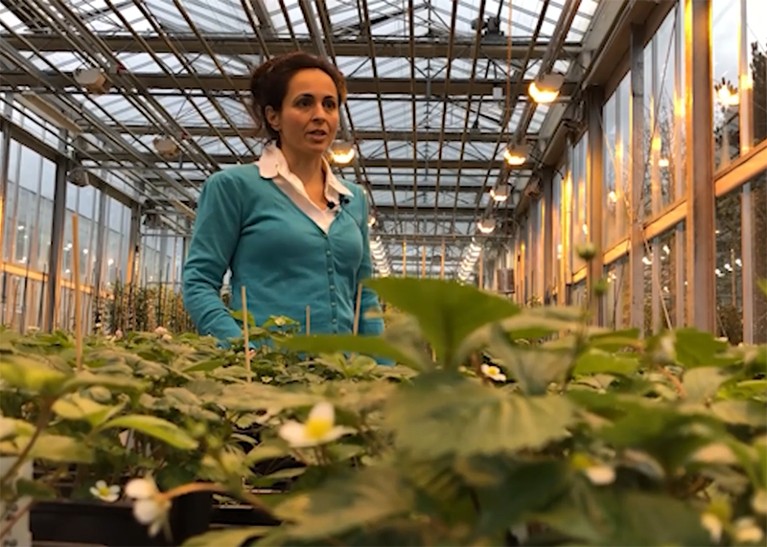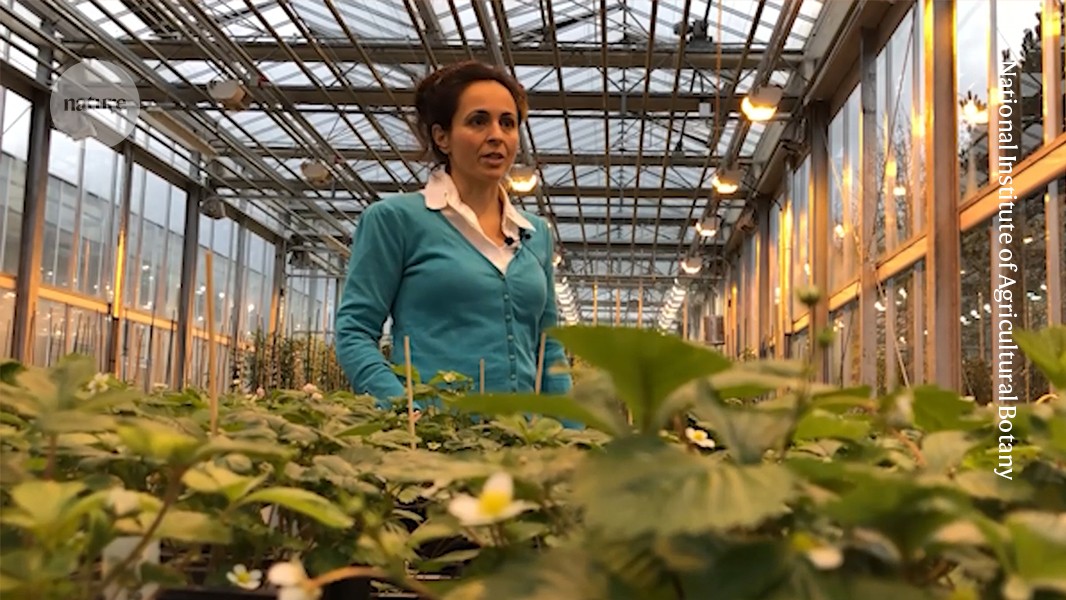
Monica Saavedra advises people on how to move from academia into industry.Credit: National Institute of Agricultural Botany
Lambda Agri, based in Cambridge, UK, develops advanced materials to convert incident high-energy (ultraviolet, or UV) light into lower-energy (red) light efficiently. The applications of these materials include spray coatings for glass greenhouses that can increase crop yields.
Monica Saavedra, the company’s chief executive, grew up wanting to be an astronaut and first developed a taste for experimental work during her bachelor’s degree in physics, when she did a summer placement at the University of Surrey in Guildford, UK, helping researchers to make and test carbon-nanotube-based soft-matter detectors for α-, β- and γ-radiation.
After a master’s degree in nanotechnology, she undertook a doctorate in nanomaterials at the UK National Physical Laboratory in Teddington. Alongside describing her own career journey, Saavedra offers advice to early-career researchers who want to move from academia to industry. She also highlights the importance of moving fast in commercial environments, using her company’s pivot from energy to agritech as an example. This month Saavedra won a 2025 Women in Innovation award, run by Innovate UK, the country’s innovation agency.
Tell us about your career journey as an entrepreneur.
In 2012, I joined Nexeon, an early-stage company based in Abingdon, UK, developing silicon batteries. The following year, I left for a research-scientist role at Cambridge-based DNA-sequencing developer Base4 Innovation.
Four years later, I joined Solaris Photonics, also based in Cambridge, as its chief technology officer (CTO), developing materials to increase the output of solar cells. Around that time, a colleague and I discussed setting up a company to make solar cells using quantum dots, which would have a bigger output than conventional silicon solar cells. I had had a similar idea around ten years previously, when I was doing my MSc — it was one of those scribbles that you do at the side of the page while the lecturer is speaking.
The company became Lambda Agri. I was its CTO originally and became chief executive in March last year.
Being a founder enabled me to wear lots of hats — one day CTO, marketing or human resources, another day chief executive. I especially enjoy hands-on involvement, making things in the laboratory, doing prototyping projects using computer-aided design and 3D printing or advising the scientists on optical physics.
I also like how start-up companies are more agile than the large corporates; they are better enablers for inventiveness. I like the challenge of working fast. Smaller companies can bring more novelty into the practical realms of everyday life and, therefore, be instrumental in saving lives and the planet more quickly.
What were the challenges and benefits of switching roles?
Since switching to chief executive, my key focus is the financing and investor-relations side of the business. I was already involved in applying for funding, updating the pitch deck and having conversations with investors, so it was not a complete change. Investors expect the chief executive to be technical at an early-stage company, to increase credibility, so my CTO experience is beneficial.
The investment environment over recent years has been challenging, and even more so for women. In Europe, for example, start-up companies founded by women raised only 1.8% of the capital invested in start-ups by venture capitalists in 2023.
After becoming chief executive, I adopted a range of measures to get it on a firmer financial footing.
First, to minimize gender bias, I decided to approach raising funds through diversity-friendly pitch competitions (Santander X and Tech Nation are two examples).
The competitions and accelerators we participated in deviated from the current venture-capital landscape by having a much stronger female presence as the funding decision makers: approximately 30–40% female. In my experience, typically around 10–20% of venture-capital investors are female.
Second, I prioritized accelerators with grants that didn’t require match funding (a mechanism in which companies have to invest an equal sum from another source into the grant-funded project). Third, I sought equity-free funding (capital funding that does not transfer ownership of the company to investors).
These measures help to keep investors happy by minimizing dilution, which is the reduction in the percentage of existing shareholders’ equity that occurs when new shares are issued.
On one occasion, I attended a national pitch competition when I was heavily pregnant with my second child. Luckily, a representative of a family office (an investment fund managing a family’s private wealth) who was in the audience really enjoyed the pitch, and invested £100,000 (US$124,000).
I live in hope that pitching events will one day be baby-friendly. At the time, I was working days, nights and weekends, with a toddler to look after as well. I have not had a day off, not even on the day my second child was born four months ago. The company has always been the ‘other baby’. I do not necessarily recommend this way of working to others, but it works for me as a mother, and I do have support, which is important.
Fundraising requires a focused effort that cannot stop until it’s achieved by a drop-dead deadline. Your employees have families to feed. People you care about have invested money in the business. You have to make it work if you believe in the vision, which we all do.
Getting the funding in place, despite the challenges, has helped me to work on my communication skills, which I always found difficult. Previously, I was much more comfortable with computers than with people. I have had to work hard to understand how to relate better to others and in the male-dominated corporate environment.
How do you attract talent?
Some scientists are technically brilliant and bold, but lack the commercial or contextual view needed to produce things as quickly and cost-effectively as possible. This is sometimes difficult to deduce before making a new hire. When I’m hiring, I only stop looking once at least one very talented and driven woman has applied.
Currently, we employ five people and the overall gender balance is 40:60 female to male. We are striving to attain a better one, ideally a 50:50 split, particularly at board level. Just now, it’s me and two white British men, both very knowledgeable angel investors.
I try to ensure that women’s technical skills are being recognized, and I do not let anyone assume that they will be more suited to people-facing roles, for example. Stereotypes about women’s capabilities in science, technology, engineering and mathematics still persist.


